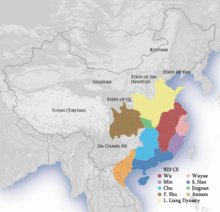Ten Kingdoms
| Ten Kingdoms | |||||||
 |
|||||||
| Traditional Chinese | |||||||
|---|---|---|---|---|---|---|---|
| Simplified Chinese | |||||||
|
|||||||
| Transcriptions | |
|---|---|
| Standard Mandarin | |
| Hanyu Pinyin | Shí Guó |
The Ten Kingdoms was a period in the history of Southern China that followed the fall of the Tang dynasty in 907. It lasted until the rise of the Song dynasty, which was founded in 960. Nine of the kingdoms were in the South and one small kingdom was in the far North. Many states were de facto independent long before the Tang Empire dissolved. The last of the Ten Kingdoms, the Northern Han, survived until 979.
Unlike the Five Dynasties of northern China, which succeeded one other in rapid succession, the regimes of South China were generally concurrent, each controlling a specific geographical area. Each court was a center of artistic excellence. The period is noted for the vitality of its poetry and for its economic prosperity. Commerce grew so quickly that there was a shortage of metallic currency. This was partly addressed by the creation of bank drafts, or "flying money" (feiqian), as well as by certificates of deposit. Wood block printing became common during this period, 500 years before Johannes Gutenberg's press.
The Ten Kingdoms were:
Only ten are traditionally listed, hence the era's name. Some historians, such as Bo Yang, count eleven, including Yan and Qi but not the Northern Han, viewing it as simply a continuation of Later Han. This era also led to the founding of the Liao dynasty in the north.
Other regimes during this period were Yan, Qi, Zhao, Yiwu Jiedushi, Dingnan Jiedushi, Wuping Jiedushi, Qingyuan Jiedushi, Yin, Ganzhou, Shazhou, and Liangzhou.
...
Wikipedia
